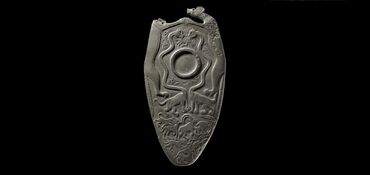Brief Identification[]


The Two Dog Palette is made of siltstone and is of the Hierakonpolis, Egypt region. [1] It is from about 3100 BCE and was excavated in 1898. [1] The Egyptian culture, archaic period, produced this artifact and it was used for ritual worship and associated with supporting the existing kingship. [2] The artifact itself is currently in Oxford's museum of art and archaeology called the Ashmolean Museum.
Technical Evaluation[]
The palette is made of a combination of siltstone and mud. [3] Siltstone is naturally occurring in "subtropical to tropical regions" and consists of "quartz, biotite, muscovite, and lesser carbonates and epidote." [4] Once this sedimentary rock is obtained from the environment, pebbles and sharp rocks were used as grinding stones to give the palette its inscriptions and texture. [3]
The materials used to make the palette were not exotic or expensive. They were locally found within the environment. The artifact was excavated in 1898 by the Egyptian Research Account group and thereafter transported to the Ashmolean Museum in Oxford. [5]
Local Historical Context[]
The archaic Egyptian period created the Two Dog Palette. During this period the ideology of kingship saw its beginning. [2] King Menes was ruling from the capital city of Memphis. To these Egyptians, "the king was a godlike being." [2] During this time most Egyptians were farmers who lived in small villages. Pottery was very prevalent during this time and these samples of siltstone and mud could be hardened. [1]
The King likely commissioned the manufacture of the palette because such "exotic creatures were adopted by Egypt's early kings to express their otherworldly status and power." [6] In order to achieve his position, King Menes needed to establish the right to rule by showing his power and how he was godlike. The common people would looks at these unfamiliar animals with amazement such as serpopards, leopards, hyenas, a griffin with comb-like wings, and dog-like creature wearing a belt and playing an end-blown flute." [5] An artifact such as this used for ritual worship would move the common people to view King Menes as divine and worthy of their worship.
World-Historical Significance[]
This artifact symbolizes Egypt's transition to a king ruled society and later a pharaoh ruled society. The divine right of kings established a precedent future rulers would use to gain the public's support. The ideas embedded withing the Two Dog Palette were received via long distance trade because some animals were not native to Egypt. [5]
Bibliography[]
- ↑ 1.0 1.1 1.2 "The Ashmolean Palette." Barbarism and Civilization. Accessed 2 December 2019. http://www.civilization.org.uk/miscellaneous/dump/egypt_old/predynastic-egypt/hierakonpolis
- ↑ 2.0 2.1 2.2 History.com Editors. "Ancient Egypt." History. A&E Television Networks. Last updated September 30, 2019. Accessed December 2, 2019.
- ↑ 3.0 3.1 "Siltstone Palettes." Egypt Centre. Accessed December 2, 2019. http://www.egypt.swan.ac.uk/the-collection-2/the-collection/siltstone-palettes/
- ↑ Zauyah, Siti; et al. "Saprolites." ScienceDirect. Accessed December 2, 2019.
- ↑ 5.0 5.1 5.2 "Two Dog Palette." Ashmolean museum of art and archaeology, University of Oxford." Accessed December 2, 2019. https://www.ashmolean.org/two-dog-palette
- ↑ "Two Dog Palette." Egypt Museum. Accessed December 2, 2019. https://egypt-museum.com/post/178187208051/two-dog-palette